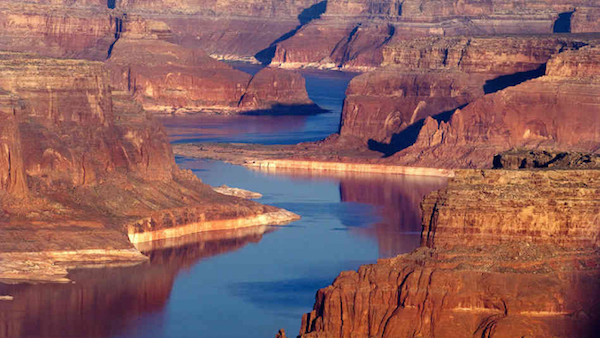Drought-Stricken Lake Mead Gets Boost From Preservation Program

From top to bottom, the mighty Colorado River is a 1,400-mile journey with 244,000 square miles of river basin that slakes thirst and grows crops for millions of residents in seven states—including 28 Indian tribes along the way.
As one of the most heavily managed rivers in the United States, it is a bellweather for water supply in the Southwest, and it’s in serious trouble.
A drought now in its 16th year (one of the worst droughts in the past 1,200 years, according to the director of the Reclamation Bureau’s Lower Colorado River region), the impacts of continuing climate change, and an increase in demand by a growing population base (already 40 million people) all contribute to the lowering of storage supplies in Lake Mead, which is formed by the river and the Hoover Dam. The river also irrigates more than five million acres of farmland in California’s Imperial Valley and Arizona’s Yuma County.

While healers look for some kind of medical miracle to reestablish the health of the waterway, a project known as the Pilot System Conservation Agreement is underway to stem the continuing loss of water in Lake Mead—at 110 miles long, the largest reservoir on the river. Termed the Leave It in the Lake program, it’s an copy1 million collaboration between the Bureau of Reclamation, the federal agency that manages the large dams, and big urban water suppliers like the Central Arizona Project (CAP).
In essence, it entails paying farmers, industries, tribes and municipalities to reduce their use of river water. Three states in the Lower Basin (Arizona, California, Nevada) and four in the Upper Basin (Wyoming, Colorado, Utah, New Mexico) are participating. Lower Basin states have gotten a bit more than $8 million for their efforts, while the Upper Basin folks will receive just under $3 million.
“This partnership demonstrates our commitment to find solutions in meeting future challenges we face in water supply and demand,” said Reclamation’s Regional Director Terry Fulp. “Our goal is to put in place a suite of proactive, voluntary measures that will reduce our risk of reaching critical reservoir levels. Depending on the success of this pilot program, it could be expanded in the future.”
The Central Arizona Project is the most active player to date, initially reducing diversion from Lake Mead by 25,000 acre feet in 2014 and working to achieve as much as 160,000 acre feet in 2015 to help delay the arrival of crisis shortage levels.
“It’s a first step to address the Lower Basin risk,” said CAP Colorado River Program Manager Chuck Cullom.
“All water conserved under this program stays in the river system, helping boost declining reservoir levels and protecting the health of the entire system,” said CAP Board President Pam Pickard.
It’s been a tough battle, and success is not guaranteed. As of July, Mead’s reservoir levels had dipped to the lowest since the Hoover Dam was filled in 1937 and, under current conditions, the odds are high that the lake level will soon drop to a point where federal officials declare an official shortage. Researchers at Scripps Institute of Oceanography are already projecting a 50–50 chance that Lake Mead could continue to diminish in size and drop to what's known as dead pool, a water level below the dam’s intake level, within the next 20 years.
“What’s unique about this program is its ‘we’re in this together’ approach (where) the fund pays for voluntary reductions in water use by installing efficient irrigation systems, recycling industrial supplies, growing crops that require less water, or even fallowing farm fields,” noted National Geographic.
The latter category, or a combination of those measures, is attractive to some Native American farmers.
Already popular for the last decade in Southern California, the University of Arizona College of Agriculture reports the first farmland fallowing and forbearance project in the Grand Canyon state got started in early 2014 with volunteer farmers being paid to not grow crops, thus minimizing divergence of Colorado River water that would otherwise be used to irrigate those lands. Landowners would be paid $750 per acre of fallowed land with a maximum of 18 percent of their holdings allowed to lie untilled. Nearly three dozen farmland owners in the Yuma area are already short-term fallowing some 1,500 acres of alfalfa fields and citrus groves.
“Cropland fallowing is neither new nor uncommon in the agricultural world,” says the University of Arizona’s Water Resources Research Center. “Supporters say farmers benefit from a guaranteed paycheck while allowing soil regeneration in fallowed fields. Critics argue that fallowing negatively impacts local agriculture-based economies. Over the last decade, fallowing agreements have become popular across the West as a strategy for adjusting to decreasing water supplies in stressed river basins.”
Tribal water rights are intertwined with the Law of the River, noted authors Amy and Daniel Cordalis, writing in the Arizona Journal of Environmental Lawin April.
“For thousands of years before the Law, American Indians lived and irrigated within the Colorado River Basin, making due with seasonal rains and difficult growing conditions,” they said. “Today, in a cruel—but all too common—twist, 12 of the basin’s 28 tribes have not had their water rights completely quantified, leaving many of the basin’s oldest inhabitants without a legally secure source of water.”
Twenty conservation proposals have been received so far in the Leave It In The Lake project, with grants to be announced in early September.
“I can’t tell you which tribes submitted proposals, but I can say we’re close to finalizing an agreement with one of them—an Arizona tribe from the Lower Basin—and that’s all I can say at this point,” commented Rose Davis, spokesperson for Reclamation’s Lower Colorado Region.
Read more at http://indiancountrytodaymedianetwork.com/2015/08/31/drought-stricken-lake-mead-gets-boost-preservation-program-161432